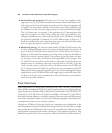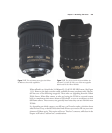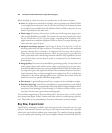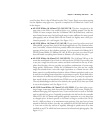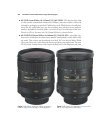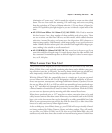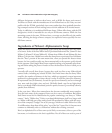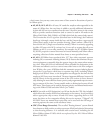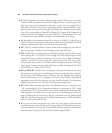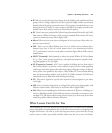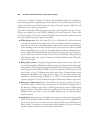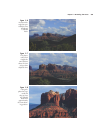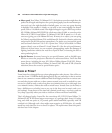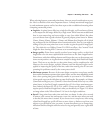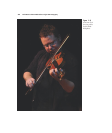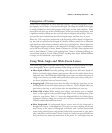■ E. The E designation was used for Nikon’s budget-priced E Series optics, five prime
and three zoom manual focus lenses built using aluminum or plastic parts rather
than brass, the preferred material in those days, so they were less rugged. All are
effectively AI-S lenses. They do have good image quality, which makes them a bar-
gain for those who treat their lenses gently and don’t need the latest autofocus fea-
tures. They were available in 28mm f/2.8, 35mm f/2.5, 50mm f/1.8, 100mm f/2.8,
and 135mm f/2.8 focal lengths, plus 36-72mm f/3.5, 75mm-150mm f/3.5, and
70-210mm f/4 zooms. (All these would be considered fairly “fast” today.)
■ D. Appended to the maximum f/stop of the lens (as in f/2.8D), a D Series lens is
able to send focus distance data to the camera, which uses the information for flash
exposure calculation and 3D Color Matrix II matrix metering.
■ DC. The DC stands for defocus control, which allows managing the out-of-focus
parts of an image to produce better-looking portraits and close-ups.
■ DX. The DX lenses are designed for use with digital cameras using the APS-C–sized
sensor having the 1.5X crop factor. Their image circle isn’t large enough to fill up
a full 35mm frame at all focal lengths, but they can be used on Nikon’s full-frame
D3/D3x and D700 models using the automatic/manual DX crop mode.
Theoretically, these lenses can be built smaller and lighter than their full-frame
counterparts, but there are some hefty DX lenses available, including the AF-S DX
Zoom-Nikkor 17-55mm f/2.8G IF-ED.
■ ED (or LD/UD). The ED (extra low dispersion) designation indicates that some
lens elements are made of a special hard and scratch-resistant glass that minimizes
the divergence of the different colors of light as they pass through, thus reducing
chromatic aberration (color “fringing”) and other image defects. A gold band
around the front of the lens indicates an optic with ED elements. You sometimes
find LD (low dispersion) or UD (ultra-low dispersion) designations.
■ FX. When Nikon introduced the Nikon D3 full-frame camera, it coined the term
“FX,” representing the 23.9 × 36mm sensor format as a counterpart to “DX,” which
was used for its 15.8 × 23.6mm APS-C-sized sensors. Although FX hasn’t been offi-
cially applied to any Nikon lenses so far, expect to see the designation used more
often to differentiate between lenses that are compatible with any Nikon digital
SLR (FX) and those that operate only on DX-format cameras, or in DX mode when
used on an FX camera like the D3.
■ G. G-type lenses have no aperture ring, and you can use them at other than the
maximum aperture only with electronic cameras like the D7000 that set the aper-
ture automatically or by using the command dial while the exposure compensation/
aperture button is depressed. This includes all Nikon digital dSLRs.
David Busch’s Nikon D7000 Guide to Digital SLR Photography356



